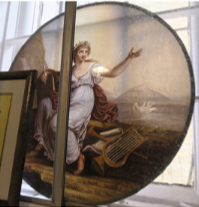Art Collection
Painted Glass Roundels by Francis Eginton

Depicting two of the four muses, early-19th century.
Francis Eginton (1737-1805) was a multi-talented decorative artist. He was employed by Matthew Boulton and was the chief designer and modeller of metalware, as well as decorator of Japanning. Eginton perfected the method of producing coloured copies of paintings, sometimes called ‘polygraphs’, with Matthew Boulton. These have been mistaken for original paintings or photographs. He eventually became a very successful English glass painter, reviving the art of glass painting and producing many works of consequence, including stained glass for: St. George’s Chapel, Windsor; Salisbury Cathedral; Lichfield Cathedral; Tewksbury Abbey; Oxford Colleges; and many churches and large houses. Eginton sent much of his work abroad; some of his finest stained glass is thought to be in Amsterdam. In 1791 Eginton completed what was considered his masterpiece, The Conversion of St. Paul, for the east window of St. Paul’s Church, Birmingham. This was based on an altarpiece painted in 1786 by Benjamin West PRA, which is presently held by the Dallas Museum of Art.
No record has been found to provide the roundels with any provenance, including whether they are connected to the ‘transparent painting’ by Benjamin West PRA that is recorded as having been in the parish church. However, there may be some record in the London Metropolitan Archives, City of Westminster Archives Centre, or National Archives.
